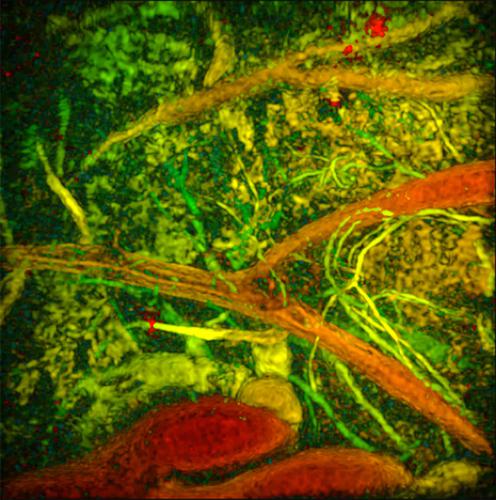当前位置:
X-MOL 学术
›
J. Biophotonics
›
论文详情
Our official English website, www.x-mol.net, welcomes your feedback! (Note: you will need to create a separate account there.)
Photoacoustic imaging of the human placental vasculature.
Journal of Biophotonics ( IF 2.8 ) Pub Date : 2019-11-25 , DOI: 10.1002/jbio.201900167 Efthymios Maneas 1, 2 , Rosalind Aughwane 2, 3 , Nam Huynh 1, 2 , Wenfeng Xia 2, 4 , Rehman Ansari 1, 2 , Mithun Kuniyil Ajith Singh 5 , J Ciaran Hutchinson 6, 7 , Neil J Sebire 6, 7 , Owen J Arthurs 6, 8 , Jan Deprest 1, 3, 9 , Sebastien Ourselin 2, 4 , Paul C Beard 1, 2 , Andrew Melbourne 2, 4 , Tom Vercauteren 2, 4 , Anna L David 3 , Adrien E Desjardins 1, 2
Journal of Biophotonics ( IF 2.8 ) Pub Date : 2019-11-25 , DOI: 10.1002/jbio.201900167 Efthymios Maneas 1, 2 , Rosalind Aughwane 2, 3 , Nam Huynh 1, 2 , Wenfeng Xia 2, 4 , Rehman Ansari 1, 2 , Mithun Kuniyil Ajith Singh 5 , J Ciaran Hutchinson 6, 7 , Neil J Sebire 6, 7 , Owen J Arthurs 6, 8 , Jan Deprest 1, 3, 9 , Sebastien Ourselin 2, 4 , Paul C Beard 1, 2 , Andrew Melbourne 2, 4 , Tom Vercauteren 2, 4 , Anna L David 3 , Adrien E Desjardins 1, 2
Affiliation

|
Minimally invasive fetal interventions require accurate imaging from inside the uterine cavity. Twin‐to‐twin transfusion syndrome (TTTS), a condition considered in this study, occurs from abnormal vascular anastomoses in the placenta that allow blood to flow unevenly between the fetuses. Currently, TTTS is treated fetoscopically by identifying the anastomosing vessels, and then performing laser photocoagulation. However, white light fetoscopy provides limited visibility of placental vasculature, which can lead to missed anastomoses or incomplete photocoagulation. Photoacoustic (PA) imaging is an alternative imaging method that provides contrast for hemoglobin, and in this study, two PA systems were used to visualize chorionic (fetal) superficial and subsurface vasculature in human placentas. The first system comprised an optical parametric oscillator for PA excitation and a 2D Fabry‐Pérot cavity ultrasound sensor; the second, light emitting diode arrays and a 1D clinical linear‐array ultrasound imaging probe. Volumetric photoacoustic images were acquired from ex vivo normal term and TTTS‐treated placentas. It was shown that superficial and subsurface branching blood vessels could be visualized to depths of approximately 7 mm, and that ablated tissue yielded negative image contrast. This study demonstrated the strong potential of PA imaging to guide minimally invasive fetal therapies.
中文翻译:

人类胎盘脉管系统的光声成像。
微创胎儿干预需要从子宫腔内部进行准确的成像。双胎输血综合征 (TTTS) 是本研究中考虑的一种病症,是由于胎盘中的血管吻合异常导致胎儿之间的血液流动不均匀而引起的。目前,TTTS 的治疗方法是通过胎儿镜识别吻合血管,然后进行激光光凝。然而,白光胎儿镜检查对胎盘脉管系统的可见度有限,这可能导致吻合术缺失或光凝不完全。光声 (PA) 成像是一种提供血红蛋白对比度的替代成像方法,在本研究中,使用两个 PA 系统来可视化人胎盘中绒毛膜(胎儿)表面和表面下的脉管系统。第一个系统包括用于 PA 激励的光学参量振荡器和 2D Fabry-Pérot 腔超声传感器;第二个是发光二极管阵列和一维临床线性阵列超声成像探头。体积光声图像是从离体正常足月胎盘和 TTTS 处理的胎盘中获取的。结果表明,表面和表面下的分支血管可以看到约 7 毫米的深度,并且消融的组织产生负图像对比度。这项研究证明了 PA 成像在指导微创胎儿治疗方面的巨大潜力。
更新日期:2019-11-25
中文翻译:

人类胎盘脉管系统的光声成像。
微创胎儿干预需要从子宫腔内部进行准确的成像。双胎输血综合征 (TTTS) 是本研究中考虑的一种病症,是由于胎盘中的血管吻合异常导致胎儿之间的血液流动不均匀而引起的。目前,TTTS 的治疗方法是通过胎儿镜识别吻合血管,然后进行激光光凝。然而,白光胎儿镜检查对胎盘脉管系统的可见度有限,这可能导致吻合术缺失或光凝不完全。光声 (PA) 成像是一种提供血红蛋白对比度的替代成像方法,在本研究中,使用两个 PA 系统来可视化人胎盘中绒毛膜(胎儿)表面和表面下的脉管系统。第一个系统包括用于 PA 激励的光学参量振荡器和 2D Fabry-Pérot 腔超声传感器;第二个是发光二极管阵列和一维临床线性阵列超声成像探头。体积光声图像是从离体正常足月胎盘和 TTTS 处理的胎盘中获取的。结果表明,表面和表面下的分支血管可以看到约 7 毫米的深度,并且消融的组织产生负图像对比度。这项研究证明了 PA 成像在指导微创胎儿治疗方面的巨大潜力。



























 京公网安备 11010802027423号
京公网安备 11010802027423号